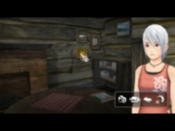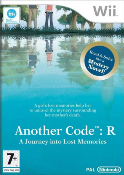Because this game has not been released in the US, I have been boycotting Nintendo published Wii games. I've missed out on Punchout, ExciteBots, and Wii Sports Resort. :(
Another Code: R - A Journey into Lost Memories Review
|
|
See PixlBit's Review Policies

On 09/27/2009 at 11:35 PM by Chessa DiMola Is this |

Regardless of the game's flaws, it still provides for a wonderful experience that many Wii owners would appreciate. All fans of Trace Memory and Ashley’s story will definitely love this game.
Back in 2005, Nintendo released a game called Another Code: Two Memories otherwise known as Trace Memory in America. The game followed the story of Ashley Mizuki Robbins, a Japanese American teenager whose scientist parents vanished when she was just a child. One day Ashley received a letter from her father, Richard Robbins, whom she presumed dead. The letter explained that he was indeed alive and waiting for her on Blood Edward Island. Ashley traveled to the island and while searching for her father befriends the spirit of a deceased young boy known only as “D”. Through a series of events, Ashley helps D unlock his past all the while allowing her to learn the dark secrets of her family’s past, including the truth about her mother’s murder.

Another Code: R – A Journey Into Lost Memories is a direct sequel to Trace Memory, and builds upon the story of Ashley and her family. The game begins by describing the reunion of Ashley and her father after the events of Blood Edward Island. Shortly after, Richard is offered a job by JC Valley, a research company located at Lake Juliet. Before the end of her summer break, Richard invites Ashley to spend a weekend with him at Lake Juliet. Upon arrival, Ashley begins having flashbacks of visiting the lake with her mother when she was only three years old. These flashbacks become increasingly more common as the story proceeds, offering insight into the story as well as direction for the player. During Ashley’s investigation, she meets a young boy named Matthew Cruso, who is searching for his lost father. Together, Ashley and Matt explore Lake Juliet together uncovering memories long forgotten, and secrets that should have remained so.
While Another Code: R - A Journey into Lost Memories remains very similar to its predecessor, it is also very different. Trace Memory felt and played like a story-based puzzle game, whereas Another Code: R feels more like an interactive novel. The main focal point of Another Code: R is the character development.

This element both helps, and hurts the game. The character development is utterly fantastic, and the depth in which each new character encountered is described, only adds to the charm and mystery of the story. However, everything should be done in moderation, and Another Code: R sometimes takes character interaction to an unnecessary level. Players will undoubtedly spend hours reading conversations between Ashley and other characters that are comprised of utter nonsense. This would not be so bad, were it not for two issues. With no option to skip through text, players are forced to read everything. Additionally, if players are not paying attention they will miss details hidden deep within some of the seemingly arbitrary conversations. These little key bits of information clue players into where they must go or what they must do next.
The other half of Another Code: R is the puzzles. There are generally five different types of puzzles that players will encounter throughout the game. One puzzle created by Ashley’s random flashbacks, is a quiz, which consist of her “remembering” what she has learned throughout the chapter. Another utilizes the DAS, a modified version of the DAS used in Trace Memory which now resembles a DSi. Players take two different photos of two different objects and superimpose them upon one another to uncover clues. Additionally there are scattered puzzles which utilize the motion capabilities of the Wii, but thankfully they are scarce, as they work horrendously due to shoddily implemented motion controls.

One of the most interesting puzzles that players will come across often consist of opening doors. Ashley carries with her a device known as the TAS: a device created by her deceased mother whose purpose seems solely associated with deactivating electronic coded locks. When players encounter a lock they must enter a series of displayed numbers, letters, or objects with their Wii Remote in order to unlock the door. However, the Wii Remote itself does not contain many of the numbers or symbols players will often see displayed on the screen, and it is up to them to figure out these puzzles. For example, if players see the number three, they will have to press “2” + “1”.
Overall, the puzzles within Another Code: R - A Journey Into Lost Memories are unique, thought provoking, and incredibly fun. My favorites by far were utilizing random objects for specific purposes, as well as opening doors with the TAS.

Exploration is a large component of Another Code: R, and players will have to navigate back and forth through many different locales in order to solve all types of puzzles.
While exploring, it’s easy to get lost in the game’s overall presentation, as it is without a doubt one of the most beautiful games available on Wii. The cel-shaded storybook look gives the characters and environments a realistic quality with a surreal touch. In addition to the fantastic graphics, the music is also terrific. Depending on the mood, or the events occurring in the background, a perfectly matched composition will play, adding to overall ambiance of the situation. Unfortunately, the soundtrack is quite short and many of the game’s tracks are often repeated.
Another Code: R - A Journey Into Lost Memories is a fascinating tale of a brave girl’s journey to discover her own past full of drama, mystery, deception, and lies. The story itself is intriguing and the scattered puzzles are both unique and interesting. However the pacing of the game is sometimes incredibly slow and leaves the player too bored to continue on for the moment. Less monotonous conversing and more intriguing puzzle solving could have taken this game from good to great.










Comments